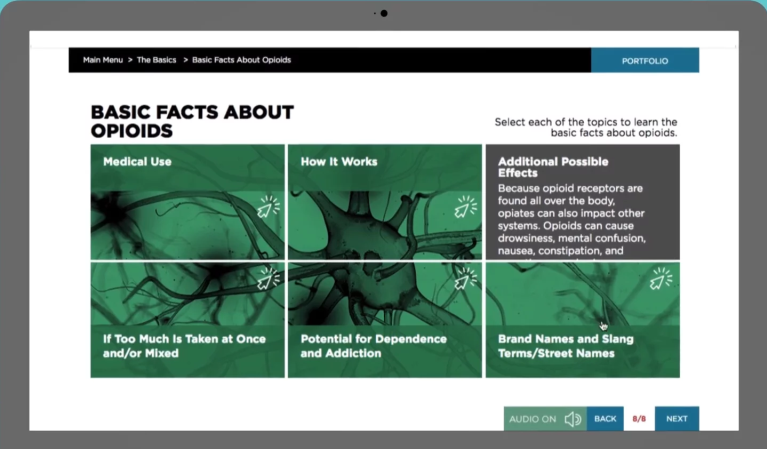2018 School Spending Survey Report
New Anti-Opioid Initiative Focuses on Prevention in Schools
A free online course for teens emphasizes education, prevention, and response.

Information from EVERFI's online course for students.
The statistics are sobering: 33 percent of teenagers believe there’s nothing wrong with misusing prescription drugs “once in a while,” while one in five teens have actually abused these drugs at least once, according to EVERFI, an education technology company that provides free virtual courses to K–12 schools and colleges. That’s why the company joined forces with health-care companies, businesses, and public officials to launch the Prescription Drug Safety Network. Its aim: to fight the opioid crisis through a prevention program targeted at high school students. “A lot of the efforts to combat prescription drug abuse are directed at the treatment end, which is understandable,” says Jon Chapman, cofounder and president of global partnerships at EVERFI. “But there hasn’t been as much effort at prevention, and we decided that there was a need here.” To fill that need, the company has created a free course to empower students to make good choices when using prescription drugs and to intervene in situations of misuse. The course format is similar to curricula EVERFI developed to teach students such life skills as developing financial and media literacy, reading social cues, and withstanding peer pressure, which is currently being used in 20,000 schools. Educators can fold these interactive, self-paced courses into their lesson plans or use them as part of a larger program in areas including alcohol abuse prevention. The prescription drug prevention course is divided into modules that teach kids about the science of addiction, how opioids work, how to read a prescription label, and how to dispose these drugs, among other topics. Other modules give kids tools—for instance, teaching them how to read warning signs—to help friends or family members who might be struggling with addiction. There are also real-life scenarios that teach students how to respond constructively when someone pressures them to take prescription drugs. “Those are the real situations that kids face,” says Chapman. “We provide the platform where kids can contemplate those scenarios and apply their decisions in a productive way.” Teachers or librarians who use the program can also host group discussions where kids can explore what they’ve learned. While Anita Cellucci, SLJ 2016 School Librarian of the Year finalist and the librarian at Westborough (MA) High School, isn’t familiar with EVERFI’s course, she applauds any program that builds awareness of mental health challenges. “I think it’s important that this learning be authentic,” she says. In her school, the health department brings in local guests who can speak about their experiences at the library. “Some of these guests are not much older than our students,” says Cellucci. One memorable speaker was Chris Herren, the former NBA player from Fall River, MA, who was addicted to painkillers and heroin and almost died of an overdose. As a community, Westborough High School students chose to read Herren’s memoir, Basketball Junkie (St. Martin’s, 2011), and then listened to Herren tell his story of drug abuse and recovery. Sports also play a role in the Prescription Drug Safety Network. EVERFI is partnering with groups including the Pittsburgh Penguin Foundation to expand the reach of its drug prevention course in high schools. EVERFI’s course has another benefit: it creates a database that can be used by educators and lawmakers in the future. The platform is powered by an assessment engine that measures what kids knew going into the program and what they’ve learned by taking it. It also measures attitude and behavior changes. “We think the data we pull together from a diverse set of students across the country will help fellow network members optimize what their student populations need to understand—how to scale what's working and how to add more information if needed,” says Chapman. The program is already being used in high schools in Arkansas, Ohio, Pennsylvania, Colorado, and Utah. If you’re interested in bringing the course to your school or library, Chapman urges you to contact them, either by going to EVERFI’s micro drug prescription site or the main site. “We won't be the silver bullet," says Chapman—but "we can have a positive effect.”Linda Rodgers covers health and education for a variety of magazines and websites.
RELATED
RECOMMENDED
CAREERS
The job outlook in 2030: Librarians will be in demand
CAREERS
The job outlook in 2030: Librarians will be in demand
ALREADY A SUBSCRIBER? LOG IN
We are currently offering this content for free. Sign up now to activate your personal profile, where you can save articles for future viewing






Add Comment :-
Be the first reader to comment.
Comment Policy:
Comment should not be empty !!!